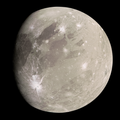Contents


Ganymede has been divided into 15 quadrangles. [1]
| Name | Number | Latitude | Longitude |
|---|---|---|---|
| Etana | Jg1 | 65-90° N | 0-360° W |
| Perrine Regio | Jg2 | 21-66° N | 0-90° W |
| Galileo Regio | Jg3 | 21-66° N | 90-180° W |
| Philus Sulcus | Jg4 | 21-66° N | 180-270° W |
| Nun Sulci | Jg5 | 21-66° N | 270-360° W |
| Dardanus Sulcus | Jg6 | 22° N-22° S | 0-72° W |
| Memphis Facula | Jg7 | 22° N-22° S | 72-144° W |
| Uruk Sulcus | Jg8 | 22° N-22° S | 144-216° W |
| Tiamat Sulcus | Jg9 | 22° N-22° S | 216-288° W |
| Misharu | Jg10 | 22° N-22° S | 288-360° W |
| Nabu | Jg11 | 21-66° S | 0-90° W |
| Osiris | Jg12 | 21-66° S | 90-180° W |
| Apsu Sulci | Jg13 | 21-66° S | 180-270° W |
| Namtar | Jg14 | 21-66° S | 270-360° W |
| Hathor | Jg15 | 65-90° S | 0-360° W |
